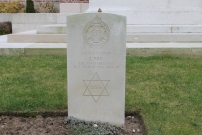| First Name: | Sidney | Last Name: | FOX | |
|---|---|---|---|---|
| Date of Death: | 21/03/1915 | Lived/Born In: | Spitalfields | |
| Rank: | Rifleman | Unit: | Rifle Brigade2 | |
| Memorial Site: | ||||
Current Information:Age-19 Born-Spitalfields
The Battle of Neuve Chapelle Between 10th and 13th March, 1915, the Indian Army Corps and IV Corps attacked the village of Neuve Chapelle in the Artois region of France. During the winter of 1914-1915, reinforcements had arrived from Britain and this was seen as an opportunity to use them to break through the German lines. It started well. At 7.30am on 10th March, a 30 minute hurricane bombardment destroyed the German wire and front line trenches and at 8.05am the infantry went in. Neuve Chapelle was captured and over a mile of the German line taken. But that was the end of the success. The British chain of command was weak and their communications poor, which was hardly surprising given that many of the troops had no previous experience of battle. The Germans re-organised and reinforced during the night and no further gains were made. British casualties mounted to 12,000 by the time the offensive petered out on 13th March. Leading the attack of 25th Brigade, 8th Division on 10th March were the 2nd Lincolnshire and 2nd Royal Berkshire battalions attacking on a 400 yard front. They moved across No Man’s Land with little loss and took the German front trench and by 8.20am they had reached the German support line. At 8.35am, the 2nd Rifle Brigade and 1st Royal Irish Rifles battalions started forward. They advanced by companies and almost immediately “C” Company on the right captured over thirty Germans waving a white flag in trenches some 200 yards to the right, between themselves and the attack by the Indian Corps. Contact was then made with the Gurkhas in the Neuve Chapelle itself where the German resistance was weak. Scouts and bombers reached the Smith Dorrien Trench which was then occupied and consolidated by “B” Company whilst others lay out in front covering them Unfortunately this covering party was hit by their own artillery barrage and suffered a number of casualties. A further advance could have been made had 23 Brigade, further to the left, not come to grief on the wire as only a few German reinforcements arrived. Instead 2nd Rifle Brigade were ordered to entrench and along with 1st Royal Irish Rifles they built breastworks from fallen masonry as the ground was too water-logged for digging and the Smith Dorrien Trench was uninhabitable. Most of their casualties came during this period of consolidation. In the early morning of 11th March, 23 Brigade, relieved 25 Brigade but a misunderstanding meant that the trenches of 2nd Rifle Brigade, east of Neuve Chapelle main street, were not included, so 2nd Rifle Brigade remained in position, a situation that caused confusion for the rest of the day and resulted in planned attacks being cancelled. Meanwhile the Germans were digging in and improving their defences. The 12th March was a day of squandered heroism for 2nd Rifle Brigade that resulted in over 250 casualties. Much of the blame must lie with Brigade and Divisional commanders who failed to understand the true position on the ground. Overnight orders were received to renew the attack at 7am, but before this could happen, the Germans launched their own attacks which resulted only in the deaths of many Germans. At 12.30pm 2nd Rifle Brigade and 1st Royal Irish Rifles attacked but the barrage that preceded this was so weak that it inevitably failed in the face of German machine guns, with great loss of life. Nevertheless they were ordered to attack again at 5.15pm, which they did with the same tragic results. This attack and other equally futile efforts elsewhere marked the end of the fighting at Neuve Chapelle. Between 13th and 20th March, 2nd Rifle Brigade remained on the ground they had captured heavily shelled and sniped especially during the first three days. Sidney Fox died from wounds on 21st March after having been sent to a base hospital on the coast and was very likely to have been one of those wounded during this battle. |
||||
| « Back to Search Results | ||||
| If you think any of the information shown here is incorrect, Click Here to submit your amends and comments | ||||




